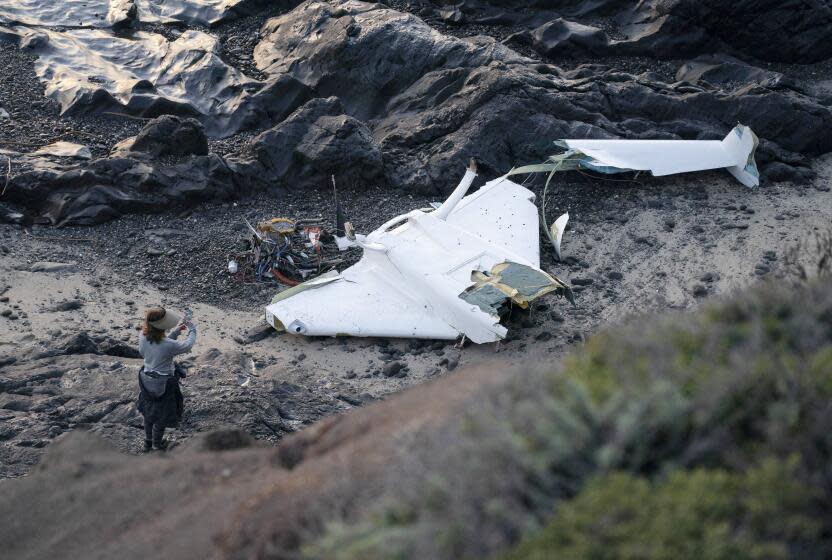Plane in fatal Half Moon Bay crash was 'amateur-built,' considered experimental

The small plane that crashed this week off the coast of Half Moon Bay, Calif., was an "amateur-built" experimental craft, according to its federal classification.
But experts say that designation, which would typically limit where and when the craft could be flown, is not necessarily the reason for its fatal plunge.
The Cozy Mark IV — a four-seat, single-engine plane — crashed soon after taking off from Half Moon Bay Airport on Sunday evening, according to the National Transportation Safety Board. The four people on board, including the pilot, are now presumed dead, though only one person's body has been recovered and identified: 27-year-old Emma Willmer-Shiles, of San Francisco.
The NTSB is still investigating the crash, and it's unclear whether the aircraft's construction will be part of the probe. Agency spokesperson Sarah Taylor Sulick said aircraft maintenance will be one prong of the investigation, as will other potential factors such as weather and the pilot's background.
Read more: Woman's body discovered after small plane crash in Half Moon Bay
Investigators will also review any air traffic control communications and available surveillance footage or witness statements.
The small plane was considered a "home-built aircraft," available for at-home construction with raw materials and prefabricated parts — making it part of a small subset of U.S. planes, according to Robert Ditchey, an expert in airplanes and aviation litigation based in Marina del Rey.
“This particular kind of airplane and the market for this type of airplane is minuscule," Ditchey said. "Not many people want to build an airplane or have the time and money to do it."
Because such planes are built by different people, often their owners, the process is less regulated and the aircraft "can be a hazard to the public," he said.
Read more: Small plane that crashed off Half Moon Bay carried 4 people; 1 victim identified, officials say
Such planes are classified by the Federal Aviation Administration as experimental.
"Experimental registration of aircraft normally carries with it a severe limitation of where the aircraft can be flown, and under what conditions that flight may be performed," Ditchey said.
There are only 83 Cozy Mark IV planes registered with the FAA, all classified as experimental on account of their home construction. It wasn't immediately clear how many other "amateur-built" planes are currently registered.
The aircraft that crashed was registered in August by an Oakland-based company, Winged Wallabies Inc. The Times was unable to identify anyone affiliated with that company.
Ditchey said he wouldn't assume the plane's construction led to its deadly flight this week. If he had to guess — based only on his experience in the field, not direct knowledge of this case — he said it was more likely to be an engine issue.
"It's probably having something to do with power failure or power loss, and the engine is not home-built," he said. "You could have a builder's problem in how the aircraft was assembled, but that would really be a one-of-a-kind thing."
Read more: How will the Boeing 737 Max 9 problem affect air travel?
He pointed out that the plane was spotted traveling erratically before it nosedived.
“There can be a relationship between erratic maneuvering of the airplane and power loss," he said.
Witnesses reported seeing the plane flying erratically before falling out of sight, sparking a search Sunday night. But that effort was called off early Monday after searchers were unable to locate any of the passengers.
Willmer-Shiles' body was later spotted by a commercial fishing boat, and parts of the plane were found washed ashore, local officials said.
Read more: Boeing to increase quality inspections on 737 Max following Alaska Airlines blowout
If the engine is recovered, Ditchey said investigators will be able to determine if a power issue was at fault — but other potential problems, including construction flaws, would be harder to discern given the aircraft's severe damage.
Sulick said the NTSB's preliminary report should be ready in two to three weeks. But a final report, which will include the crash's probable cause, could take up to two years to publish.
Ditchey said there's less urgency for answers in more isolated situations like these, as opposed to issues potentially affecting larger commercially built fleets — like the in-flight blowout of a door plug on a Boeing 737 Max 9 operated by Alaska Airlines earlier this month.
This story originally appeared in Los Angeles Times.

